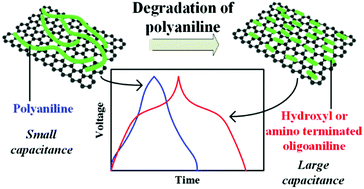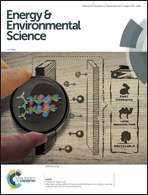Degradation-induced capacitance: a new insight into the superior capacitive performance of polyaniline/graphene composites†
Abstract
Polyaniline/graphene (PANI/graphene) composites are the most investigated electrode materials for supercapacitors, owing to their high specific capacitance and excellent rate performance. However, a specific capacitance larger than the theoretical limit of the composite has been frequently reported for PANI/graphene composites, and the reason for this over-high capacitance has not been understood. In this work, after systematically investigating the evolution of the electrochemical and spectral properties of PANI/graphene, we prove that the hydroxyl- or amino-terminated oligoanilines generated from degradation of PANI possess a large specific capacitance (>1000 F g−1), and they significantly increase the total specific capacitance of the composite electrode. Graphene in the composite serves as a conductive matrix for electron transport between the low-conductivity hydroxyl or amino-terminated oligoanilines and the current collector. Based on the above results, we put forward a suggestion for simultaneously improving the specific capacitance and cycling stability of the PANI/graphene composites. A PANI/reduced graphene oxide composite material with a specific capacitance of 719 F g−1 at 1.4 A g−1 and 91.3% capacitance retention after 10 000 cycles is obtained.



 Please wait while we load your content...
Please wait while we load your content...